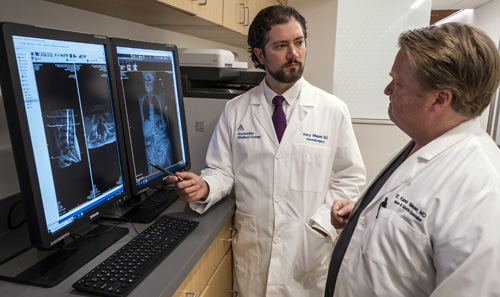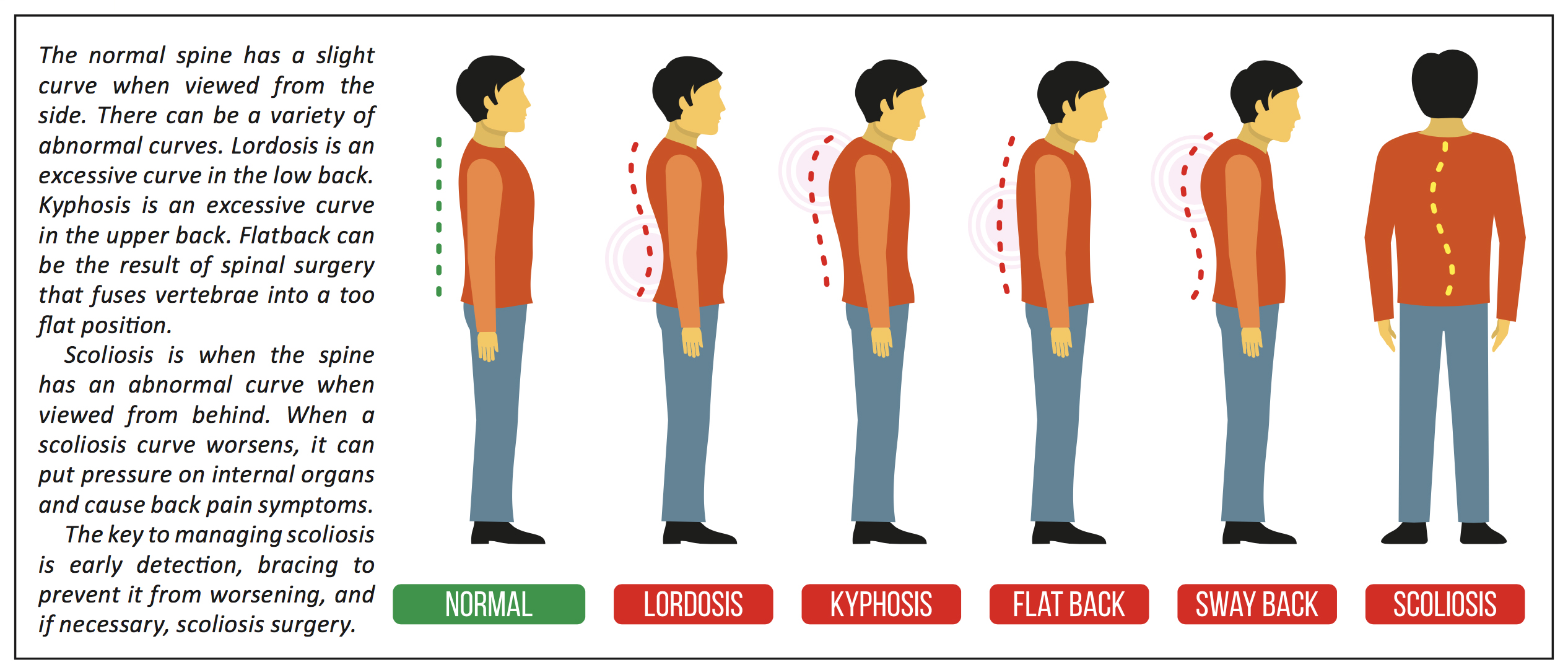Scoliosis
 Overview of Scoliosis / Lordosis / Kyphosis
Overview of Scoliosis / Lordosis / Kyphosis
Scoliosis is a disease characterized by an abnormal curvature to the spine, in which the vertebrae twist like a bent corkscrew. In less severe cases, scoliosis may cause the bones to twist slightly, making the hips or ribs appear uneven. When this occurs, the problem is more cosmetic and less of a health risk.
Scoliosis does present a health risk if bones are so severely twisted that they compress vital organs, or if the spinal deformity is so severe that spine health and posture is threatened. If this happens, surgery may be necessary. If left untreated, severe cases of scoliosis can shorten a person's life span.
The normal spine has a slight curve when viewed from the side. There can be a variety of abnormal curves. Lordosis is an excessive curve in the low back. Kyphosis is an excessive curve in the upper back. Flatback can be the result of spinal surgery that fuses vertebrae into a too flat position.
Scoliosis is when the spine has an abnormal curve when viewed from behind. When a scoliosis curve worsens, it can put pressure on internal organs and cause back pain symptoms.
The key to managing scoliosis is early detection in childhood, and then in adolescence, bracing the curve to prevent it from worsening. If necessary, scoliosis surgery may be required in a person’s teen years, or later when they are an adult.
At Texas Spine and Scoliosis, Dr. Matthew Geck specializes in pediatric and adult scoliosis and Dr. Rory Mayer focuses on adult scoliosis.
Under modern scoliosis surgery, new instrumentation corrects the scoliotic curve by untwisted the spine for a more natural correction which in turn prevents more serious spinal problems from developing.
Some of the symptoms include having trouble maintaining a proper posture, low back pain and thigh pain. Since the person has trouble maintaining proper alignment, the symptoms might increase throughout the day due to fatigue. Patients might also have upper back and neck pain due to constantly trying to realign themselves. These symptoms can often develop to be very painful and leads some patients to having to rely on painkillers, which in turn have complications to internal organs.
Consequently many patients with Harrington Rods develop FLATBACK SYNDROME which requires replacement of these older antiquated rods with more modern options that prevent future complications.

Causes
Scoliosis is in most cases a painless condition that can progress unnoticed for years. Ultimately, as the curve worsens, it causes an abnormal curvature in the spine. This will often result in a rotation of the spine and rib cage, which affects the symmetry of the shoulders, trunk and waist.
Although many cases of scoliosis can be mild, severe scoliosis can be disabling, inflicting excruciating back pain as a symptom.
Certain conditions like cerebral palsy, may actually cause scoliosis, but in most cases the cause of scoliosis is unknown.
Sometimes there can be a hereditary tendency to pass along the problem from generation to generation.
The exact cause of scoliosis is unknown. Only 1-4 percent of the population has this condition. It is more common in women than men and most often affects adolescents between the ages of 10 and 18. A child's likelihood to develop scoliosis is much higher if their parent or a sibling has it. Scoliosis can also develop over time in mid- to late childhood, usually before puberty. In other cases, the disease is congenital, meaning a person is born with a vertebral abnormality that causes it.
Types of Scoliosis
The three main types of scoliosis are Functional, Neuromuscular, and Degenerative. Functional scoliosis is where the spine is normal, but over time an abnormal curve develops due to another aliment in the patient’s body, such as having one leg longer than the other.
Neuromuscular scoliosis can usually be much more severe since the condition is present at birth. This type of scoliosis is due to the failure of the spine bones to properly form, or fail to correctly separate from each other. People born with birth defects or cerebral palsy can often have neuromuscular scoliosis.
Degenerative scoliosis is found in adults where the weakening of normal ligaments and other soft tissues of the spine can lead to an abnormal curve in the spine. Many times this can be linked to the patient having complained about arthritis.
Idiopathic scoliosis is not linked to a known cause, but it is the most common type of scoliosis in adolescents. Doctors are unsure what causes this type of scoliosis, but it is suggested that it is hereditary because the disorder tends to run in families.
Congenital scoliosis is a condition where there is deformity in the spine present at birth, but typically it is revealed only as the baby continues to grow. The cause of congenital scoliosis is abnormally shaped or fused bones in the spine that do not grow or fuse correctly. Children diagnosed with more advanced scoliosis can often feel like they sometimes have trouble breathing. They are also prone to more back and leg pain symptoms.
Because kids are fairly flexible, spinal curves can progress unnoticed for years without any symptoms. This explains why school screenings are important to detect scoliosis early on. During the screening, a school nurse or pediatrician may notice a hump, uneven shoulder blades or hips, or an “S” shaped curve in their spine. The potential for the curvature in the spine to worsen is linked to the amount of growth remaining in the bones and spine. This growth may relate to the treatment decision and recommendation from the scoliosis surgeon.
One way to determine how much growth has yet to take place is to perform an X-ray of the pelvic hip region. Another way is to note the changes of puberty in girls and boys which can give insight if the person has more growth left. In girls, evidence suggests that after their first period, there may be one to two more years of spine growth remaining.
How scoliosis progresses
Most of the time the patient is unaware of the curvature in their spine until it is noticed by someone else. Some of the warning signs to look for are shoulders at different heights, appearance of a uneven waist, rib cages at different heights, leaning of entire body, fatigue, backache, low-back pain and head not aligned with the pelvis. These signs and symptoms typically begin in adolescence when boys and girls hit their growth spurt.
Boys and girls develop mild scoliosis around the same rate, but interestingly, girls have an increased risk of the scoliosis worsening. Severe scoliosis — a curve greater than 100 degrees — can create dangerous problems. The spinal curve can encroach upon the lungs and heart, as well as other organs, making it more difficult to breathe and for the heart to pump blood flow properly.
If there is uncertainty that you or your child might have scoliosis, you should see a scoliosis specialist to get evaluated. School examinations include Adam’s Forward Bend Test for scoliosis. This test has the child bend over and touch their toes, which exposes the spine to the examiner so he or she can easily detect any abnormal spinal curvatures. Additional testing can be done by taking an X-ray from the front and the side to get a clearer view of the spine’s alignment. A scoliosis specialist will monitor the patient over several follow up visits to compare the results of the previous visits to get a better idea of the pace of the progression of the spinal curve.
Symptoms
Sometimes, the symptoms of scoliosis are visible. For instance, the child may have uneven shoulders, chest, hips, shoulder blades, waist, or a child may have a tendency to lean to one side. In other cases, there are no visible symptoms. To diagnose a child with scoliosis, have them touch their toes. If either one or both shoulder blades are prominent, the waist is shifted or ribs are uneven, scoliosis may be present. For a child or teenager, your pediatrician often screens for scoliosis. There are school screening programs as well.
Treatment Options for Scoliosis
The treatment of scoliosis is based on the severity of the curve and the potential of the spine to curve even worse. Scoliosis treatment involves observation, bracing, and in severe cases where the curve is worsening, surgery. The first step is to observe if the curve is worsening or staying the same over time.
Bracing is not effective for adults with scoliosis. For adults, scoliosis over time can cause discs to herniate from the pressure placed on them from the curve. Another complication can be osteoporosis, where the vertebrae in the spine become porous and brittle, causing vertebral fractures. This can limit the surgical treatment options.
FAQs
How can I tell if I have scoliosis?
Your doctor will take X-rays of your spine which will reveal whether or not scoliosis is present as well as how severe it may be.
When is scoliosis considered dangerous to my health?
Scoliosis can be life-threatening when bones are so severely twisted that they compress vital organs. Surgery is most likely the best option in such cases. If left untreated, severe cases of scoliosis can shorten a person's life span.
What are some of the nonsurgical ways to treat scoliosis?
There are some nonsurgical ways to treat scoliosis such as physical therapy, exercise, bracing, shoe inserts and medication. However, only a spine surgeon can determine if any of these options might apply to you.
